For Long-Term MTA funding, Look to a State Carbon Tax
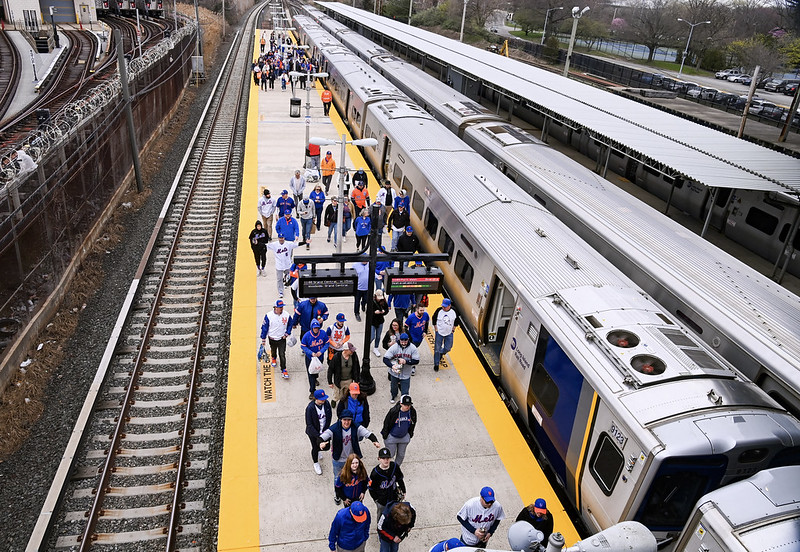
Subway ridership in view (photo: Marc A. Hermann/MTA)
That huge sigh of relief from New York City mass transit advocates last weekend was for the state budget handshake to tack more than a billion additional dollars a year onto a key MTA funding stream, the Payroll Mobility Tax. According to both my calculations and an announcement from Gov. Kathy Hochul, the agreed-to 75% rise in the tax rate on employee salaries paid by businesses in the five boroughs will add $1.1 billion to the PMT’s ongoing annual $1.8 billion take.
(The numbers prorate imperfectly because the rise in the tax rate, to 60/100 of one percent, applies only in the city; the rate in the seven suburban MTA counties remains 34/100 of one percent.)
The upward bump in the PMT is part of the package to avert a fare hike and service cuts that would have jolted the entire metro region. Raising the same $1.1 billion via the subway farebox, for example, would have required a whopping 35% jump in fares, a calamity that would have triggered enough new car, cab, and Uber trips to slow vehicles in Manhattan by 5% and boosted city and regional carbon emissions by nearly 400,000 tons of CO2 a year — enough to negate the climate benefit of 90 new large wind turbines, according to my modeling. And these figures don’t include lost jobs and commerce from worsened transportation. Reducing service to save the same amount would have produced similar bad outcomes.
Score a big win, then, for transit and New York. But the new revenue comes with a downside: taxes on payrolls discourage hiring and compound our area’s anti-business aura. Moreover, this revenue infusion will almost certainly be not the last but the first in a series the MTA will require throughout the decade to limit future fare hikes and improve service even as ridership continues to lag pre-pandemic volumes. Counting on raising the PMT next time, and the time after that, will be a fool’s errand. There has to be a better way.
I believe there is: enact a modest statewide carbon tax and dedicate a third to a half of the revenue to shoring up public transportation budgets around the state, though principally in New York City.
Reappraising Carbon Taxes
On January 1, Washington state launched its carbon-pricing program, the nation’s second all-sectors carbon charge, with a starting price around $20 per ton of CO2, though most of the emission allowances fetched even higher prices in the first carbon auction, in March. I estimate that the same $20 price applied to all fossil fuels burned in New York State could generate revenues of $3 billion a year (see table).
Dedicating a third of those proceeds to the MTA would add a billion dollars to the authority’s annual revenue. Other slices of the revenue could cure deficits at smaller transit systems around the state.
Even with these allocations, roughly half of the new $3 billion in annual carbon revenues would remain available for a range of purposes from home weatherization to rebates offsetting higher fuel costs for lower-income rural New Yorkers.
Of course, no new tax is ever welcomed with open arms. In recent years, moreover, carbon taxing has lost political standing with left and right alike.
|
|
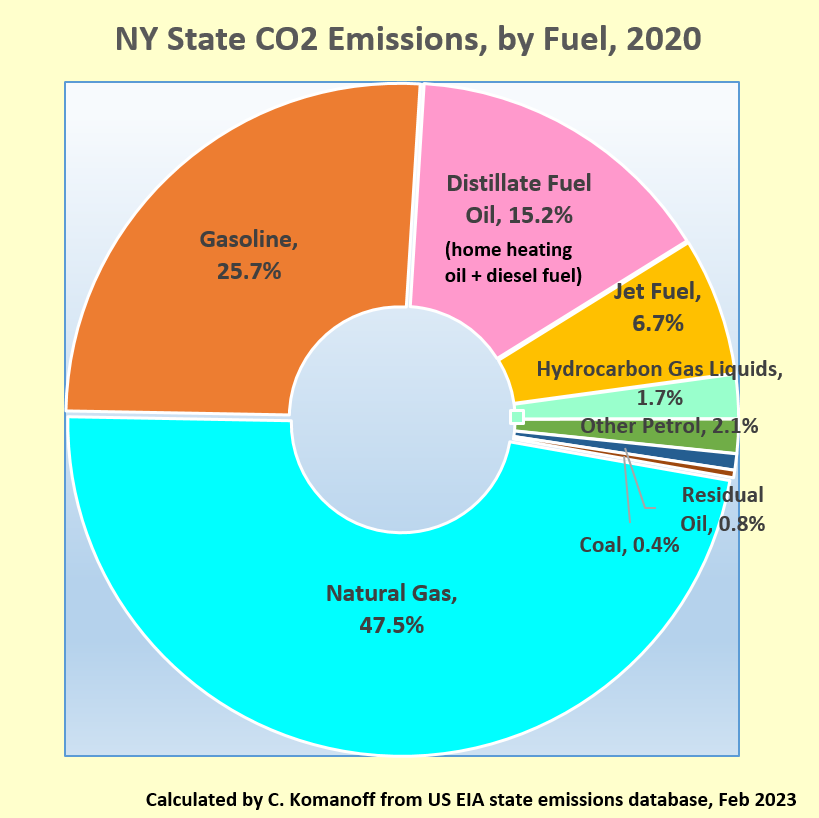 |
Right-wingers, in thrall to fossil fuels, denigrate the very idea of climate concern. Opinions on carbon pricing on the left, while far more nuanced, tend toward an “eat your peas” quality, seeing the promised revenues but not the powerful tides unleashed by the increased fuel prices.
Could a state carbon tax have a chance in New York this time around? I believe so, if only because MTA deficits are untenable and a statewide carbon tax looks like the least-bad long-term antidote.
Consider:
- New York wouldn’t be the first state to price all carbon emissions. California has done so for a decade, and, as noted, Washington just followed suit.
- Two-thirds of the $3 billion in carbon tax revenue could go to other, non-MTA uses across the state.
- Nearly half of the revenues would come from charges on fossil (natural) gas, the very fuel that climate activists are targeting in order to electrify heating and cooking while also shrinking climate-damaging methane leaks from pipelines, wells, and buildings.
- Carbon taxing’s regressive bias (it takes more dollars from the rich but more proportionally from the poor) would be blunted by its helping keep a lid on transit fares.
- The affluent suburban counties that will be on the hook for the carbon tax caught a big break by their exemption from the increase in the Payroll Mobility Tax. Moreover, some pro-climate suburbanites might even support a climate-helping carbon tax.
- Upstate households will be cushioned from the tax by the region’s preponderance of low-carbon electricity from nuclear, hydro, and wind power.
- Aid to transit could be packaged as an urban corrective to suburban- and rural-facing Inflation Reduction Act federal subsidies for solar panels, electric vehicles, and heat pumps. (Notably, the IRA does not fund urban-friendly mass transit and e-bikes.)
- Left-leaning climate-justice advocates who shy away from carbon pricing might warm to a policy that cuts emissions by attracting car trips to buses, trains, and subways.
This panoply of advantages points to diverse potential sources of support for a transit-benefitting state carbon tax:
- NYC transit and “livable streets” advocates;
- Economic-justice advocates who recognize affordable transit’s value in combating poverty;
- Climate campaigners who see carbon pricing as a complement to other carbon-cutting policies;
- Suburbanites concerned that future hikes in the Payroll Mobility Tax will come for them;
- “Electrify-everything” proponents working to eliminate fossil gas from residences and other buildings;
- Developers of low-carbon electricity — not just solar and wind providers but proponents of retaining the state’s four upstate reactors and building new ones;
- Energy-efficiency engineers, contractors, and workforces;
- Labor unions whose members fabricate, erect, and maintain the spectrum of green energy projects that a carbon tax will help make more abundant by making fossil sources costlier.
Competing Claimants?
Electricity producers in New York already pay a carbon fee under the multi-state Regional Greenhouse Gas Initiative (RGGI) cap-and-trade program. In addition, Governor Hochul and the statewide climate coalition New York Renews have advanced competing carbon pricing concepts, both of them, somewhat confusingly, dubbed cap-and-invest. Hence, an MTA-focused carbon tax, which would employ a carbon-based charge on fossil fuels extracted or imported into New York State rather than a carbon cap enforced through sales of emission permits, wouldn’t arrive on a blank slate.
RGGI currently charges electricity producers around $14 for each ton of CO2 their generators emit. This levy is generating $365 million of statewide revenues a year, paid as surcharges on power bills, which goes to support investments in energy-efficiency and renewable electricity. While in theory the RGGI charge could be netted against the new carbon tax, the relative ease and importance of decarbonizing electricity production make it preferable to retain it and add the carbon price on top.
Cap-and-invest presents a trickier set of issues, partly because neither the governor’s prospective program included in the new budget nor NY Renews’ more elaborate plan has been fully fleshed out. In addition, the latter is the fruit of years of deliberation and consensus-building among the coalition’s hundreds of participant grassroots groups, who now constitute a formidable host.
At this writing, NY Renews envisions applying $10 billion in carbon revenues over several years in no less than 73 individual spending buckets grouped in four uber-categories: Climate Jobs and Infrastructure includes elements like aiding electric bus manufacture ($100 million) and offshore wind power supply chains ($300 million). Energy Affordability earmarks $1 billion to wipe out utility customer debt and $2 billion to support building electrification. Community & Worker Transition Assistance devotes $600 million to the “just transition” from jobs in carbon fuels to positions in renewable energy. And Community Directed Climate Solutions sets aside $2 billion to unspecified projects in historically underserved and overburdened urban neighborhoods and rural areas.
The NY Renews plan should be seen, then, as a holistic roadmap to make over not just how energy is supplied in the state but how it is consumed and governed. Billion-dollar-a-year allocations to the MTA aren’t the kind of investment its members have envisioned. Nevertheless, exploratory calculations suggest that the carbon payoff from service improvements paid for by a state carbon tax would be impressive.
As an illustration, I have calculated that an average 20% speed-up in subway trips achieved by running more trains at higher speeds would save straphangers and drivers each around 100 million hours a year (the latter from car trips switching to trains) while reducing car and truck emissions by 900,000 tons a year. Even more CO2 would be eliminated because of New York City’s improved competitive advantages vis-a-vis less “inherently green” suburbs and exurbs.
To be sure, so striking a gain in subway performance would almost certainly carry a price tag well over a billion dollars a year. Still, the prospective benefits underscore both the carbon-cutting potential of infusing new funds into subway service and the need to score competing claims for their climate value.
Broader Considerations and Next Steps
Over time, the carbon tax’s revenue base will shrink as its price incentives kick in and other carbon-cutting policies also gather steam. The resulting loss in tax revenues could be counteracted by periodically raising the per-ton tax rate. New York City could supplement the tax through revenue-generating street-management measures such as curbside pricing and other forms of road pricing.
Earlier this year, Community Services Society CEO (and MTA board member) David R. Jones and Riders Alliance executive director Betsy Plum proposed expanding New York City’s Fair Fares program to allow an additional 772,000 lower-income New Yorkers to qualify for half-fare transit passes. The cost, which they put at $142 million a year, should be a candidate for the carbon spending package.
This discussion has centered on the carbon tax’s creation of a new funding pot to maintain and improve transit affordability and performance. But taxing carbon emissions stands to benefit society in two other major ways. It will diminish financial incentives propping up carbon fuels and also support societal paradigms promoting care over harm.
A carbon tax is more than just a pay-for, in other words. Simply making it more expensive to buy and burn carbon fuels discourages fossil fuel use in a multiplicity of ways. Moreover, the very act of pricing carbon emissions can spur “externality taxing” in other realms, from congestion pricing to taxing the sugar content of soft drinks. Making New York the third U.S. state with broad-based carbon pricing will also add momentum to long-sought federal carbon emissions pricing.
Shoring up MTA finances, while reason enough to enact a state carbon tax, isn’t the lone consideration. The crisis of transit funding should be seen as a catalyst to pricing fossil fuels more closely to their true societal costs — a vital goal in its own right.
The next MTA funding crisis-as-opportunity will be upon us soon. The Legislature should move swiftly to study the benefits of taxing carbon emissions as a way to hold the line — and more — on transit fares and service, well in time for next winter’s budget negotiations. Transit and climate advocates and their counterparts in the Hochul administration should consider integrating a transit-focused carbon tax into their agendas.
Taking $3 billion a year for any public purpose, no matter how noble, is no small matter. The time to start selling a transit-supporting state carbon tax is now.
***
Charles Komanoff is a long-time policy analyst and environmental activist who directs the Carbon Tax Center. On Twitter @Komanoff.
***
Have an op-ed idea or submission for Gotham Gazette? Email This email address is being protected from spambots. You need JavaScript enabled to view it.
The Importance of the New York Court of Appeals
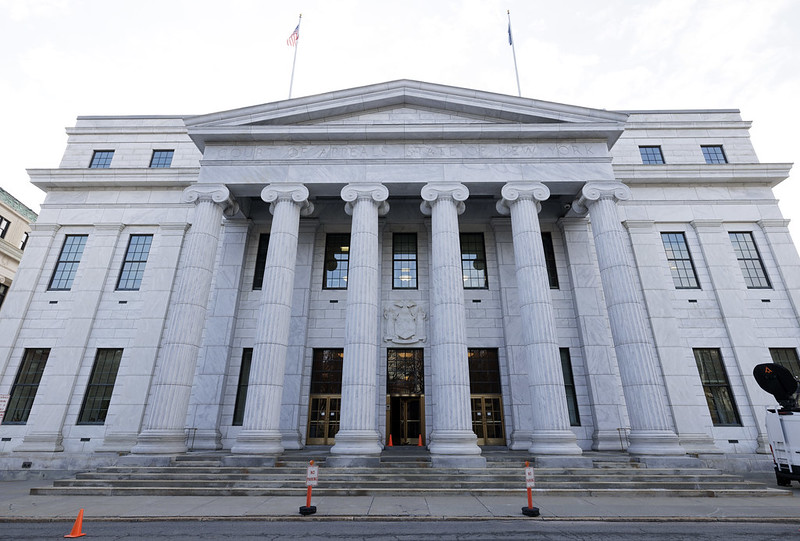
The Court of Appeals (photo: Mike Groll/Office of Governor Kathy Hochul)
Courts are much in the news these days. The Supreme Court’s recent rulings on abortion, gun control, and other issues have stirred controversy. Here in New York, the lengthy process of the governor nominating and the Senate approving a new Chief Judge of the Court of Appeals has raised public interest in the Court’s role. People are reminded that the courts, particularly the state’s and nation’s highest courts, are the final arbiters of crucial public policy issues. Their decisions have far-reaching consequences for our lives.
That highlights the importance of the New York Court of Appeals. The state’s highest court is the forum of last resort in deciding social, economic, political, and constitutional issues that are essential to New Yorkers. Even more, since its creation in 1846, the Court of Appeals has arguably been the most important state court in the nation, the one that the highest courts in other states, and sometimes the U.S. Supreme Court, look to for insight. The high court’s status and prestige was so high that one of its Chief Judges, Alton B. Parker, was nominated for president of the United States by the Democratic Party in 1904 (he lost to Theodore Roosevelt).
The Court of Appeals’ role is further underlined by the fact that, during most of our history, the key social, economic, political, and constitutional issues were settled at the state level. Litigation in the federal court system, commonplace today, was in the past more limited. Appeals to the U.S. Supreme Court were more rare than today.
Why does the New York Court of Appeals matter so much?
The Court of Appeals is sometimes seen as something of a buffer and a bulwark of liberties.
“It is vital that we restore the court to its position of national pre-eminence and ensure that the public is confident in the court’s integrity,” said Associate Judge Rowan Wilson in his Senate confirmation hearing to be Chief Judge (he was soon confirmed). “The court’s role and legitimacy is particularly important now, in the face of the U.S. Supreme Court’s retreat from several of its seminal decisions.”
“State courts are where the issues that are most important to the day-to-day lives of New Yorkers get addressed,” said Caitlin J. Halligan in her Senate hearing to be confirmed as a new Associate Judge of the court, succeeding Rowan Wilson (she was soon confirmed). “It is where the scope of the New York constitution gets hammered out, a task that is especially important at a moment when federal courts appear to be pulling back on some key constitutional protections.”
Judith Kaye, Chief Judge from 1993 to 2008, wrote that “state court dockets comprise the battlefields of first resort in social revolutions.” They must exercise judicial discernment and judgment. “State courts have openly and explicitly balanced considerations of social welfare and have fashioned new causes and action where common sense justice required.”
The Court of Appeals is a model of judicial deliberation.
The high court considers cases that have already made their way up through the state court system, including the supreme court and appellate division. Extensive evidence is presented and considered in those courts. The Court of Appeals reviews the procedures and decisions in the lower courts to make sure that the proceedings were fair and that the law was applied correctly and in line with provisions of the state and U.S. constitutions.
The court has seven members, the Chief Judge and six Associate Judges. Court decisions are collective ones, reached after careful discussion among the judges where conflicting perspectives are aired and alternative outcomes proposed. The Chief Judge presides and may try to persuade his colleagues one way or the other, but the associate judges are independent-minded and the Chief Judge’s influence is limited. Individual judges try out proposed opinions, listen to each other to gain insights, and hold extensive discussions.
Courts are well aware of the importance and consequences of their roles. They expect scrutiny of their decisions. They weigh and balance lots of factors. They recognize the need to explain the basis for the decisions. Sometimes, this results in arbitrary, biased decisions. But usually it results in decisions that are reasonably balanced and carefully explained even if that does not align with various groups’ views of what they think the court should have done.
The Court exercises a high degree of judicial statesmanship.
The Court of Appeals often strikes a judicious balance between two positions. The first is the conservative philosophy of interpreting the constitutions narrowly, focusing on the original meaning of their provisions, and clinging to the precedent of past court decisions – the legal doctrine of “Stare Decisis,” a Latin term that means “let the decision stand.”
The second position is to be more expansive, construing the constitutions more broadly, looking for ways to interpret them in light of contemporary life, thereby keeping them fresh and relevant.
This may sometimes involve articulating “common law,” sometimes called “judge-made law,” defined by the Cornell Law School Legal Information Institute as “law that is derived from judicial decisions instead of from statutes.” Courts do this cautiously, basing their decisions on the implications of the constitutions and precedent or analogy to other decisions. Their decisions, in effect, become law.
State legislatures may nullify a decision by passing new legislation to do so. More often, the legislatures take heed of the court’s reasoning and often codify common law rules from the courts of their state, “either to give the rule the permanence afforded by a statute, to modify it somehow (by either expanding or restricting the scope of the common law rule, for example) or to replace the outcome entirely with legislation,” as the Cornell Legal Information Institute explains.
The “judge-made law” role may sometimes put the high court in a somewhat uncomfortable, high-visibility position. As Chief Judge Kaye wrote, “given the enormous volume of state court litigation, the unending array of novel fact patterns pushing the law to progress, and the inability of state legislatures to react immediately to the many changes in society…courts interpreting statutes and filling the gaps have no choice but to ‘make law’ in circumstances where neither the statutory text nor the ‘legislative will’ provides a single, clear answer.”
The Court of Appeals can be expected to continue deciding tough, high-consequence cases. Its new Chief Judge and new Associate Judge may change the Court’s take on constitutional issues somewhat. But it seems likely that the court will continue, and may even expand on, its history as a judicious but proactive court.
Judges in writing their opinions, and courts in issuing their decisions, have as one audience other judges, attorneys, others involved in the cases, legislators, and others. But they also intend their opinions for the media and for the general public. The media of necessity summarize decisions and editorial writers, pundits, and partisans may pick out particular points and put their own interpretation on the decision. But interested members of the public can and should read the decisions for themselves. They are posted on the courts’ websites. Sometimes the decisions may seem laden with legal jargon. But the best ones are clear, distinct, and direct.
***
Bruce W. Dearstyne is a historian specializing in New York history. In 2022, SUNY Press published the second edition of his book The Spirit of New York: Defining Events in the Empire State's History and his newest book The Crucible of Public Policy: New York Courts in the Progressive Era.
***
Have an op-ed idea or submission for Gotham Gazette? Email This email address is being protected from spambots. You need JavaScript enabled to view it.
New York City Finally Faces Down Facial Recognition

New NYPD technology (photo: Michael Appleton/Mayoral Photography Office)
Many of you have heard some of the horror stories already, how facial recognition technology can track our movements in truly creepy ways. For some people, the moment of realization came last winter, when a mother was ejected from the Rockettes and threatened with separation from her daughter through use of facial recognition.
Proponents of the creepy tracking tech claim it keeps us safe, but what was this mother’s crime? She worked for a law firm that had sued the owners of Radio City, where the iconic Christmas show is performed.
The case showed so many that the threat from facial recognition simply can’t be ignored any longer, but we have been doing just that, ignoring the growing threat for years. Facial recognition already tracks New Yorkers at work and at home. It tracks where we shop and where we seek out entertainment. It’s seemingly everywhere, but oftentimes we have no idea.
That may soon change. This week the New York City Council is considering legislation that would begin to ban facial recognition and other biometric technology. If landlords or store owners want to use your body to track your movements, that abuse may soon be a thing of the past. And the legislation couldn’t come a moment too soon.
My colleagues and I first began calling for a ban on facial recognition more than two years ago as part of the Ban The Scan coalition. Since then, the technology has only become cheaper and more easily abused. Surveillance vendors not only scan our faces, but often take images from social media, using our personal photos to track us against our will.
Some of you may use your face to unlock your phone or computer. Don’t worry, that won’t change. Using your face to unlock a device is night and day compared to using millions of New Yorkers’ faces as a tracking tool. If you choose to use facial recognition for convenience, that’s your choice. But the technologies being used in housing, stores, and elsewhere today are used against us, not for us.
These systems log our movements and make our location accessible to landlords and the companies that own stores and venues like Radio City. For tenants, this can mean being watched in your own building, having a constant log of your movements and visitors.
This is particularly alarming for rent-stabilized tenants. Landlords can use these logs to claim a tenant isn’t using an apartment as their primary residence, when really they’re absent for another reason, such as being in the hospital.
Cheap, ubiquitous tracking isn’t a feature, it’s a threat. How can you tell? Landlords and store owners never allow their own movements to be tracked in the same way.
James Dolan, the owner of Madison Square Garden and Radio City, whose facial recognition barred that mother from the Rockettes, shows publicly what can often go unseen. When facial recognition and other forms of biometric tracking go unchecked, the rich and powerful can use it however they see fit. They can settle grudges, target rivals, and silence critics.
What’s unusual about Mr. Dolan isn’t that he abused the technology at his fingertips, but that he was so open about it. Imagine a city where anytime you post something negative on social media about a company you risk being barred from their premises for life. That sort of corporate tyranny isn’t possible without the cheap, ubiquitous tracking enabled by facial recognition.
But as important as the pending City Council legislation may be, as crucial as it is to safeguard New Yorkers from this tracking at home and in public accommodations, there still is a vital piece missing: The NYPD.
Police use of facial recognition grew rapidly in recent years, with tens of thousands of New Yorkers scanned by the technology. Even as the tech is proven to be biased against Black, Latino, and Asian New Yorkers, and after a string of high-profile facial-recognition-fueled false arrests across the country, the NYPD has made no effort to address its dangerous use of this error-prone technology.
Just as with stores and landlords’ facial recognition, we’ve called for years for a ban on police use of the technology, only to be stalled by City Council bureaucracy. As we finally take these crucial, belated steps to address the technological tracking trauma inflicted on New Yorkers every day, we must also finally bring forward legislation to ban New York City’s own abuse of the technology. Only then will we truly be able to safeguard our city from the dystopian future these technologies threaten.
***
Albert Fox Cahn is the founder and executive director of the Surveillance Technology Oversight Project (S.T.O.P.), a New York-based civil rights and privacy group, a TED fellow, a Technology and Human Rights Fellow at the Harvard Kennedy School’s Carr Center, and a visiting fellow at Yale Law School’s Information Society Project. On Twitter @FoxCahn & @StopSpyingNY.
***
Have an op-ed idea or submission for Gotham Gazette? Email This email address is being protected from spambots. You need JavaScript enabled to view it.
Why We Should Abolish the NYPD's Gang Database, Not Reform It
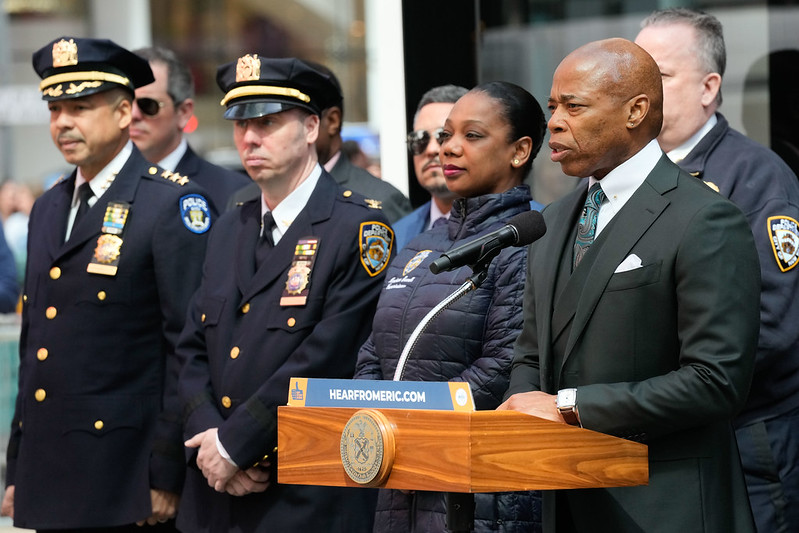
Mayor Adams and NYPD officials (photo: Michael Appleton/Mayor's Office)
This week's report from the Office of the Inspector General of the NYPD (OIG), pointed out numerous irregularities in how the NYPD manages their Criminal Group or “gang” Database (CGD). While these irregularities in procedure confirm our concerns that the database is overly broad, racially discriminatory, and arbitrary, the procedural reforms proposed by the OIG fail to address the larger unexamined issues of whether the existence of such a database is good policy. We think it isn’t and instead support City Council bill 360 that calls for the abolition of the gang database.
In 2018 and 2019 the Grassroots Advocates for Neighborhood Groups & Solutions Coalition (GANGS) testified before the City Council about our concerns that the database uses overly vague criteria for including people in the database, lacks oversight, includes juveniles without notifying their parents, refuses to tell people if they were on the database, and offers no mechanisms for disputing inclusion. The new OIG report confirms all of these concerns.
The fact is that secret databases like this inevitably give rise to shortcuts, arbitrariness, and discrimination. For instance, the OIG found numerous instances in which people were added based on a singular social media report or based on the undocumented allegations or without the required sign off by a supervisor. In addition, entire public housing developments have in essence been labeled a “known gang location” making anyone living there subject to inclusion on the list.
The OIG report also confirmed earlier reports that 99% of those on the list are non-white. In essence, they have defined “gangs” in such a way that they only include people from non white communities, despite the fact that violence, drug dealing, and other collective criminal behavior occurs in a wide variety of neighborhoods. In addition, there are many juveniles in the database including some who are 11 years old. No effort is made to communicate with their parents or provide these young people with much-needed support.
While the OIG report documents a variety of procedural failures it starts off with a claim that it couldn’t find any harms related to inclusion on the database, but later admits that it didn’t really look for them because they would be difficult to find methodologically. But this flies in the face of other reports by similar offices that were able to identify concrete harms. The OIG for the Chicago Police Department found misidentifications, harassment, obstacles to immigration, and racial profiling, all of which they argued furthered the historical divide between the community and the police and contributed to inequities, especially in communities of color.
The GANGS Coalition members have already documented concrete harms including the use of gang designations to deny people bail, enhance sentences, deny someone employment with the city, and contribute to differential treatment by police on the street. While the NYPD OIG found that the database plays a role in how street level policing is conducted, it made no effort to assess whether that treatment might involve unwarranted harassment and abuse, which has been found in other cities and which our members report.
All of this and more has led many to contemplate reforming the database by putting in place more transparency and oversight, but such efforts are both ineffective at getting at the real problem and doomed to failure.
The NYPD has made it clear that it opposes any meaningful reforms and has a history of obstructing them.The OIG report calls for the notification of parents whose children are on the database as long as it doesn’t compromise an existing investigation. But, when the City Council floated this idea, the NYPD said that it would oppose this because of its belief that everyone on the list meets the definition of being part of an active investigation.
We must also ask what the ultimate purpose of reform would be. Small procedural changes to the database generally serve to reinforce the use of police to manage the problems of youth violence.
There are alternatives. The Mayor’s Office of Criminal Justice supports several Cure Violence sites that employ community outreach workers known as “credible messengers” to work in high violence communities to identify and respond to potentially violent situations and work with young people to try to break the cycle of retributive violence as well as help young people develop positive paths forward through educational and vocational supports. In addition, they are ramping up an Advance Peace program based on the successful ones in California that enroll high-risk young people in a variety of services and provide them with income support and financial bonuses for sticking with the program. Research shows that these initiatives work.
But we need to do more.
Newark’s new Office of Violence Prevention and Trauma Recovery is a possible model. Newark Mayor Ras Baraka diverted police funding to create the office, which is using the money to create a holistic community-based response to violence that includes youth programs, outreach teams, intensive trauma counseling, summer jobs, and employment and education support. Violence in Newark is at a 60-year low with significant reductions in homicides and shootings last year. While New York City has some of these programs, they fail to cover many parts of the city and aren’t run cohesively to provide an integrated holistic approach the way that Newark does.
Abolishing the Gang Database will establish the illegitimacy of the tactic of placing large numbers of young men and boys of color in databases based on the suspicions of police. It will be a step towards shifting our emphasis away from “building cases” to repairing harms. The database is a crude and flawed tool that implicates the innocent and fails to adequately address the needs of those young people who are at risk of violence as either victims or perpetrators. Young people involved in violence have all been victims of violence themselves in ways that were never adequately addressed, leaving them scarred, angry, and often alone. If we want to end the violence we need to lift these young people up before the violence, not lock them up and throw away the key after the violence has already happened.
***
Victor Dempsey is community organizer for the Legal Defense Fund. Alex S. Vitale is Professor of Sociology at Brooklyn College and the CUNY Graduate Center. Both are members of the GANGS Coalition. On Twitter @avitale.
***
Have an op-ed idea or submission for Gotham Gazette? Email This email address is being protected from spambots. You need JavaScript enabled to view it.
What Behavioral Scientists Tell Us About Pay-to-Play in Government

Gov. Hochul delivers a check (photo: Darren McGee/Governor's Office)
Here’s a story you’ve probably heard: A CEO donates $50,000 to a state governor’s political campaign. Not long after, the CEO’s company gets a $50,000,000 contract from the state. A reporter asks the politician if it was pay-to-play, and the governor’s office says: “No donation of any size has any influence on the governor’s decisions – period.”
The politician may truly believe this, but a substantial body of research suggests the opposite: When people receive a gift, they want to return the favor. Reinvent Albany’s new report, “Buying Influence Works,” details at least 13 studies showing that corporate gifts for politicians are usually followed by political gifts for corporations. For a state like New York where business executives are free to donate up to $18,000 to the Governor while bidding on state contracts, the implications of this research are dire.
While there is plenty of evidence that gifts influence politicians, there is even more showing that drug companies influence doctors. Researchers have spent three decades thoroughly documenting the pharmaceutical industry’s efforts to influence physicians. Thanks to their research, it is now well known that gifts and payments from drug companies cause doctors to prescribe more of those companies’ drugs and use more of their equipment. Studies funded by drug companies also tend to produce findings those companies like.
Drug manufacturers market their products to doctors through a process known as “detailing.” Drug company representatives go to the doctor’s office and bring some sandwiches for the doctor and her entire staff. As the doctor eats her sandwich, the representative explains the medication (or artificial knee, hearing aid, etc.) to the doctor and addresses any concerns. Now the doctor is more familiar with the product, and she has a full stomach to boot. (Though the practice is not as common as before, ‘detailers’ also sometimes give away branded swag – pens, totes, baseball hats, coffee cups – to keep their product fresh in the doctor’s mind.)
Does detailing work? Without a doubt. One study found that even a single meal from a drug company made doctors more likely to prescribe that company’s drug, and another that doctors receiving meals from drug companies prescribed that company’s drugs at rates up to 5.4 times higher than before. Reviewing the literature, Reinvent Albany could not find a single study showing no correlation between free meals for doctors and an increase in prescriptions (though still prevalent, detailing is less pervasive than it used to be).
In the research field, one of the worst actors has been Big Tobacco, which produced mountains of pro-smoking studies after concerns about cigarettes’ health impact emerged in the 1950s. Unsurprisingly, 94% of reviews by researchers affiliated with Big Tobacco produced positive findings for the industry, compared with 13% of independent reviews. When controlling for factors such as article quality or peer review, the odds that an industry-affiliated author’s study would favor Big Tobacco were 88 times higher than for non-affiliated authors. Soft drink producers and gas companies must have been taking notes.
Like politicians, many doctors and researchers deny that they’re influenced by gifts. One survey had only 8% of doctors saying small branded gifts could affect their habits. When a pharmaceutical company paid for physicians’ trip to a symposium at a luxury resort, nine of out of ten doctors said the trip would have no effect on their prescription habits (the study, of course, found otherwise). And like politicians, physicians will acknowledge the problem of pay-to-play while claiming they themselves are immune: One survey had only 39% of medical residents acknowledging that gifts could influence their prescriptions, while 84% believed other physicians are susceptible.
What does this research say about New York State? We know that the 2022 gubernatorial election was one of the most expensive in state history, and many of the largest donors had business before the state. Elected officials claim that large contributions have no bearing on state decisions, but even if that’s true, the appearance of corruption – not to mention the state’s countless pay-to-play scandals – continues to undermine the public’s faith that the government is working for the people, not wealthy donors.
New York City understands the obvious risk of pay-to-play and limits campaign contributions from people doing business with the city to $400 for mayoral candidates and $250 for City Council candidates. Embarrassingly, New York State has not passed a single law to control this kind of behavior. As of 2023, CEOs seeking contracts from the state are free to donate up to $18,000 to Governor Kathy Hochul, $10,000 to State Senators, and $6,000 to Assembly Members.
State leaders need to do much better. They can start by passing Senator Zellnor Myrie’s common-sense bill, S6247, which prohibits business executives from contributing to the Governor while seeking contracts from the state. It’s a strong first step to win back the public’s trust.
***
Tom Speaker is a policy analyst at Reinvent Albany. On Twitter @RealTomSpeaker & @ReinventAlbany.
***
Have an op-ed idea or submission for Gotham Gazette? Email This email address is being protected from spambots. You need JavaScript enabled to view it.
Everyone Deserves the Chance for a Life-Saving Organ Transplant If They Need It
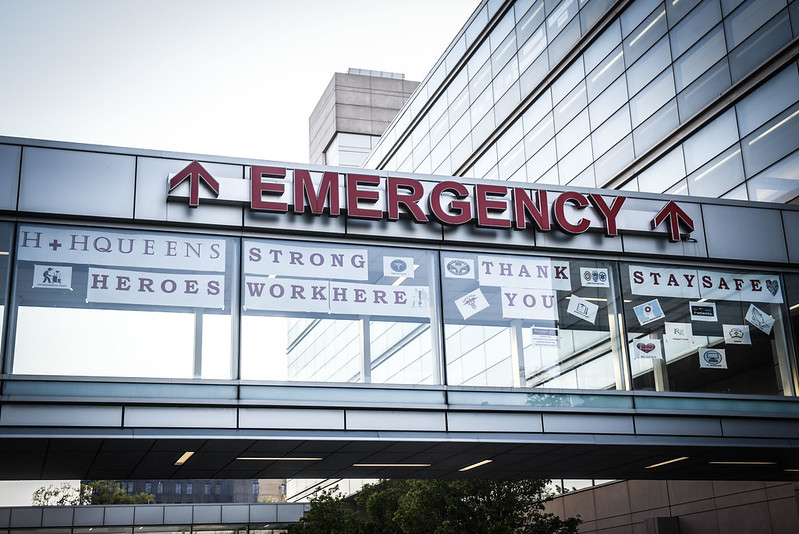
Emergency (photo: Michael Appleton/Mayoral Photography Office)
Imagine that one day you wake up with a slight cough. Thinking it is a cold or allergies, you take over-the-counter cough medicine, cough drops, and even at-home remedies. Five months later, nothing seems to be working and, at your wife’s urging, you finally go to the doctor. He runs several tests and a few weeks later you get a call to come back to the office. The doctor has devastating news: “Miguel, you have Stage 4 lung cancer and you need a lung transplant.”
But there’s hope - a transplant could save your life. You are only 36 and otherwise healthy; you have a son who just turned 7, a loving and happy marriage, and so much to live for.
But you are also undocumented, so unless you can come up with nearly a million dollars, you do not qualify to be on an organ donation list and you will not get this life-saving transplant.
We’d like to think of New York as an inclusive beacon of hope and humanity, but we are failing one of our most vulnerable populations — our undocumented immigrants. We do not have a healthcare policy that covers every New Yorker.
The emergency Medicaid program covers urgent situations for undocumented immigrants, like a tracheotomy procedure or an emergency C-section, but does not cover organ transplants. Notably, however, undocumented people can donate organs. This means that although they can donate an organ to save someone else’s life, if their own life depends on a heart, lung, or kidney transplant, they are left to die.
Undocumented people should not be handed a death sentence when an organ fails simply because they lack a piece of paper and a social security number.
Miguel’s story, while heartbreaking, happens more often than it should. According to LiveOn NY, about 6,000-9,000 undocumented people in the U.S. have kidney failure requiring a life-saving transplant. Yet, only 1% of all kidney transplant recipients are
undocumented. This jarring statistic reflects only the plight of undocumented Americans in need of a kidney transplant. Thousands more need a lung, heart, liver, or other critical organ in order to survive, but are shut out because of their immigration status.
We believe that a policy dictating who lives and who dies based on immigration status is inhumane and unethical. This is why we are introducing the Humanitarian Emergency Access for Required Transplants Act, or HEART Act, which will require the State to expand healthcare coverage to include medically necessary organ transplants, regardless of immigration status. This would ensure that someone like Miguel can be placed on the transplant list and be covered for surgery, post-medical care, and prescription drugs.
Our legislation is not without precedent. In 2014, Illinois passed a similar bill into law that expanded public health coverage for emergency kidney transplants for undocumented immigrants. Although this is a step in the right direction, we must go further in New York and cover the care needed for the transplant of any organ where a person’s life is at risk, regardless of immigration status. Our undocumented neighbors must be recognized and treated like New Yorkers, and their survival should not depend on their immigration status.
***
Assemblymember Catalina Cruz represents parts of Queens. State Senator Nathalia Fernandez represents parts of the Bronx. On Twitter @CatalinaCruzNY & @Fernandez4NY.
***
Have an op-ed idea or submission for Gotham Gazette? Email This email address is being protected from spambots. You need JavaScript enabled to view it.
A New, Safer Future for Third Ave in Brooklyn
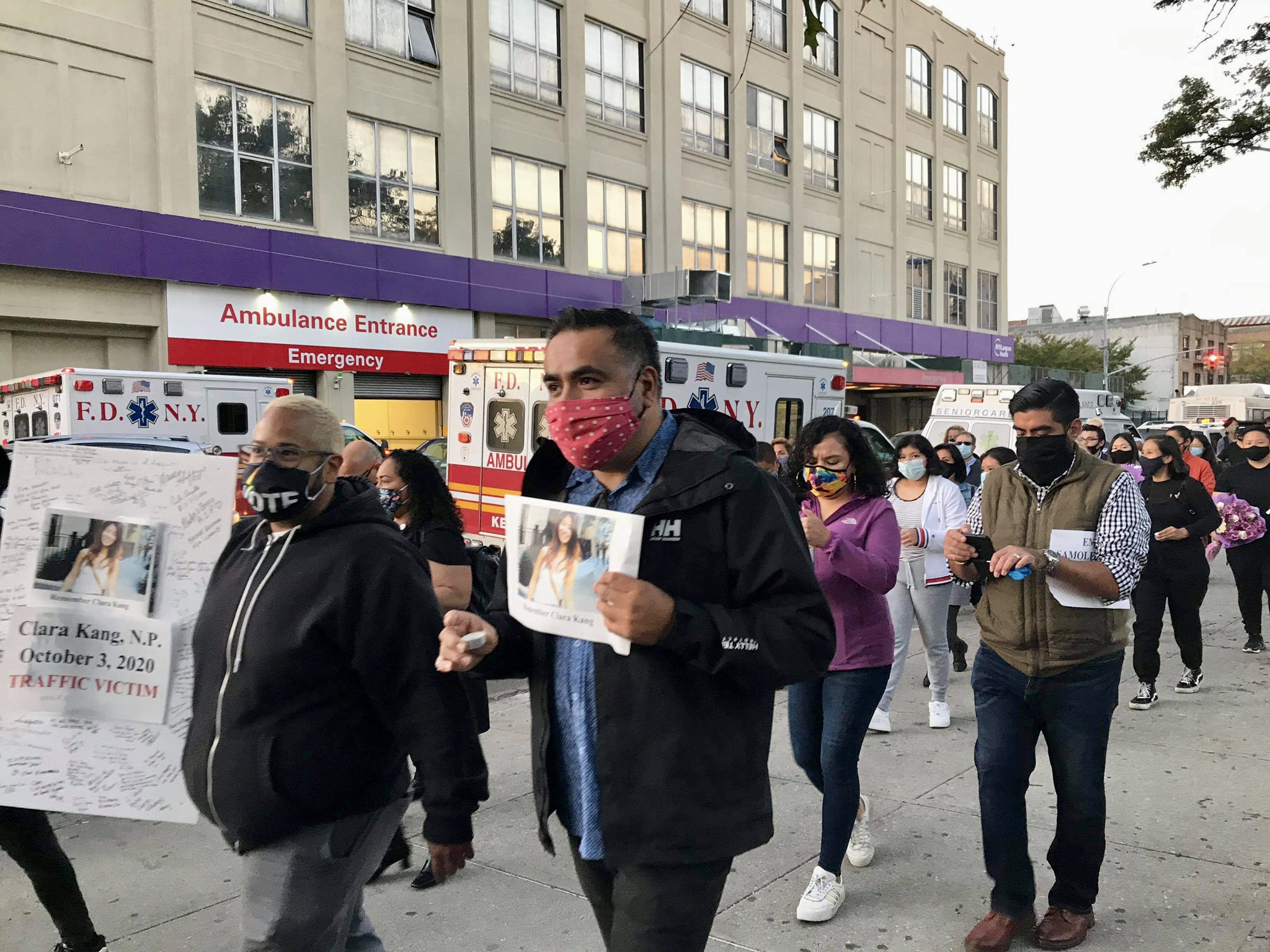
At the 2020 vigil for Clara Kang
Three years ago, my Brooklyn neighbors and I stood in Martin Luther Playground and held a vigil for Clara Kang. She was a nurse at NYU Langone Brooklyn (still called Lutheran Medical Center by locals). While we were at home during covid lockdown, Clara was literally saving lives. She was killed on 56th Street while bicycling home from a shift at the hospital.
Official after official stood in that park and told us not one more death on Third Avenue - but sadly, even after more crashes, accidents, and fatalities, little has moved the needle in fixing the corridor stretching from Prospect Ave to 65th St, leaving community members outraged and calling for change. Over the years, Third Avenue has seen an alarming number of crashes involving pedestrians and cyclists. In the last 10 years alone, there have been over 1,600 reported crashes along Third Avenue and more than 13 fatalities (see NYC Crash Mapper).
No more.
The New York City Department of Transportation (DOT) has finally heard these concerns and has begun a safety study for Third Avenue - beginning with two workshops, which are aimed at hearing about and addressing the safety issues along the corridor. The first was held on April 18 and the second and final workshop will be held on Thursday, April 27 at PS 503/506 (old school Sunset Parkers still call it PS 314). It is crucial that Sunset Park residents attend this workshop to ensure their voices are heard and that DOT understands the community's concerns.
The importance of community participation in this process cannot be overstated. The workshop organized by DOT presents a unique opportunity for the community to come together and work towards a shared solution. The workshop aims to gather input from community members on their experiences with Third Avenue and their ideas for improving safety. This feedback will be used to develop a plan for redesigning Third Avenue to make it safer for everyone who navigates the corridor — students, families, small businesses, and others.
By participating, community members can provide valuable insights into how Third Avenue can be redesigned to be safer for pedestrians, bike-riders, and drivers alike. They can share their experiences of navigating the corridor, highlight problem areas, and suggest potential solutions. In addition, community participation will demonstrate to DOT the level of urgency felt by the residents of Sunset Park. It will show that we are invested in making our community a safer place for everyone, and that we are willing to work collaboratively to achieve this goal.
The final Third Avenue Workshop organized by DOT presents a unique opportunity for the Sunset Park community to come together and work towards a safer corridor. It is imperative that community members attend this workshop and provide input and feedback to ensure that the solutions developed are in line with community needs and concerns. By doing so, we can demonstrate our commitment to making our community a safer place for everyone, and help pave the way for a safer future on Third Avenue.
***
Julio Peña III is Chair of Brooklyn Community Board 7 and has been a member of the board since 2016. The final DOT workshop on Third Avenue is Thursday, April 27 at 6:30pm at PS 503/506, 330 59th Street — learn more about the workshops and provide feedback here. On Twitter @Julio_PenaBK.
***
Have an op-ed idea or submission for Gotham Gazette? Email This email address is being protected from spambots. You need JavaScript enabled to view it.
Little Has Changed Since I was Held on Rikers; It's Time to Shift Resources as We Close the Jail
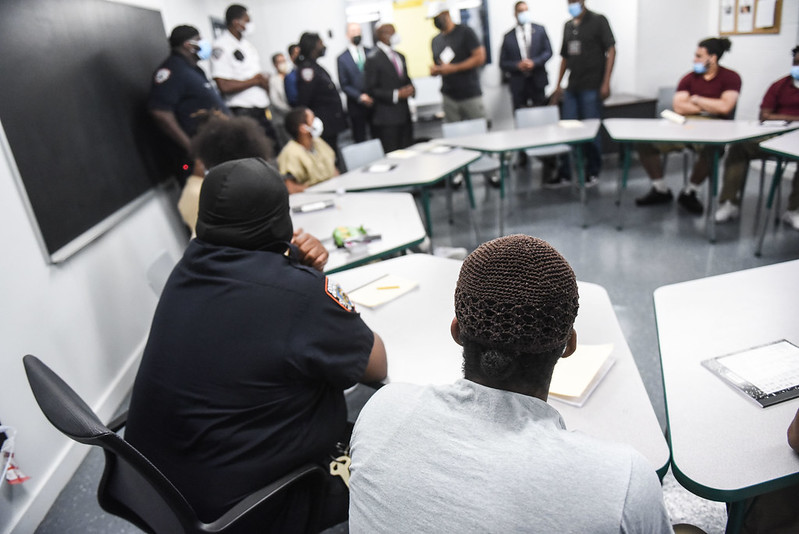
A classroom on Rikers Island (photo: Michael Appleton/Mayoral Photography Office)
I spent three-and-a-half years on Rikers Island, as both an adolescent and adult. During this time, I experienced and witnessed countless episodes of abuse and neglect, including frequent medical and mental health neglect, and the inadequacy of programming that properly prepares those detained for community reentry.
It appears that very little has changed in the 31 years since I was incarcerated, and conditions may have worsened. In the past two years, 36 people have died after being held in the custody of the Department of Correction, including 19 people last year alone.
Instead of relying on this broken system, we should close Rikers Island by 2027, as is the law, and invest in resources that will keep all of us safe: supports for those reentering our communities, such as behavioral health services, substance use treatment, medical care, employment support, and more.
Those held on Rikers are suffering needlessly and in ways that render everyone there – staff and people in custody alike – unsafe. Over half of the people in Correction’s custody have a mental health diagnosis – and between 20% and 50% desperately need consistent mental health treatment of some kind – yet from February to October of 2022, people in custody missed over 12,000 medical appointments, in part because staff were not there to escort them.
This is simply unacceptable and must not be rewarded by increasing the budget for an agency that is failing to provide basic services to those in its custody and control.
The proposed city budget for the Department of Correction represents an increase of more than $35 million, and projects that 88.5% of agency expenses are earmarked for staff salaries and benefits. This is both disproportionate and shocking, because the Department does not lack financial resources.
The problems in our jails will not be solved by increasing funding for the same line items that are not only failing to produce results but resulting in harm and death. In 2022, our city spent 350% more for each incarcerated person than the two other largest jail systems in the country — Los Angeles and Cook County, Illinois — and yet individuals in its custody are being subjected to horrific conditions.
One way that cost savings from the budget could be utilized is to enhance funding for supportive housing for people leaving jail and prison, to prevent them from returning. Current funding for Justice Involved Supportive Housing is so far below what is sufficient that no current service provider, including my organization, The Fortune Society, submitted a proposal to receive that funding.
That was a painful choice to make given the need, because the Fortune Society, which supports successful reentry from incarceration and promotes alternatives to incarceration, has been in the business of providing such housing for more than two decades.
Another solution would be to enhance the Board of Correction: the Board must have the staff necessary to perform its city charter-mandated oversight of the Department of Correction. The Board needs the resources to conduct regular, unscheduled visits to observe jail conditions and speak with people in custody, as well as Correction staff. Having eyes and ears on the ground has proven crucial to the Board’s ability to report on the circumstances surrounding the deaths of people in custody.
At The Fortune Society, we believe in the power of people to change. But the city must change as well in the face of the record number of deaths and persistent dysfunction at Rikers.
The city is bound by law to close Rikers Island by 2027. Given the waste of our taxpayer funds on a broken system, the mayoral administration must adhere to that timeline, while investing in crucial jail oversight, alternatives to incarceration programs, reentry services, and supportive housing.
This is not only a pathway to humane treatment, but also one with a proven track record of improving public safety. We can no longer avoid what has become a stain on the conscience of our city – and continue to put too many lives at stake.
***
Andre Ward is the Associate Vice President of The David Rothenberg Center for Public Policy at The Fortune Society. On Twitter @AAWardSR1 & @thefortunesoc.
***
Have an op-ed idea or submission for Gotham Gazette? Email This email address is being protected from spambots. You need JavaScript enabled to view it.
Clean Slate is Good for New York’s Businesses
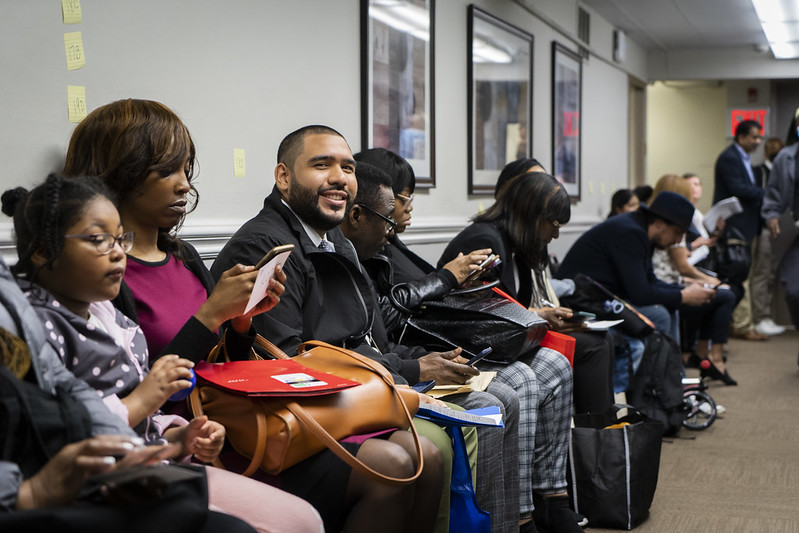
Ready to work (photo: Caroline Willis/Mayoral Photography Office)
Across New York, many employers continue to struggle to find workers.
The labor market remains tight, even amid fears about a looming recession. According to a recently released study by the U.S. Chamber of Commerce, there are over 450,000 open jobs in New York State with only about 400,000 unemployed New Yorkers. This workforce shortage has a devastating impact on the New York economy as it drives up costs, makes it difficult for businesses to expand, and becomes a disincentive for businesses to relocate to New York.
Yet there is a way for our State Legislature to help employers bring workers back into the economy, while also making our communities safer. Indeed, this is exactly what the Clean Slate Act would do (S1553-Myrie/A6399-Cruz).
It's state legislation that will seal old conviction records and enable more than 2.3 million New Yorkers to obtain jobs. This crucial bill will help businesses across New York hire employees, boost our state’s economic growth, and increase public safety.
The Clean Slate Act has growing support across the state, including from Fortune 500 companies, business groups, labor unions, and local and county legislatures.
After old conviction records are sealed, individuals are more likely to obtain jobs, stay employed, support their families, and strengthen their communities. Those are positive outcomes that will benefit every town, city, and county in New York.
According to a recent analysis, the Clean Slate Act would generate an estimated annual earnings boost to New York State of $7.1 billion.
The Clean Slate Act would automatically seal old conviction records for New Yorkers who have successfully completed their sentence, are no longer on community supervision, and have not incurred any new charges or convictions after three years for misdemeanors and seven years for felonies. We have to ask ourselves, what is enough? When people have paid their debt, when can they move forward?
These New Yorkers want to work and contribute to our economy, but are currently held back in doing so because of their old convictions. By decreasing barriers to jobs, housing, and education, the Clean Slate Act will make it easier for these New Yorkers to support themselves and their families.
Research shows that, after old conviction records are sealed, individuals are more likely to maintain employment and increase their earnings, and less likely than members of the general public to be convicted of a crime.
Let’s be clear on what this means: sealing old conviction records helps reduce crime and increase public safety because it enables more job-seekers to enter the workforce and remain employed, rather than re-engage in criminal activity.
New Yorkers of all backgrounds should welcome the Clean Slate Act. There are limits to the sealing provided in the legislation. Records remain accessible for a number of purposes, including work in certain regulated fields, as well as to law enforcement and the courts. In carefully crafting the bill, the Legislature has considered a wide array of interests, including businesses, which has contributed to the support from so many business leaders, like JPMorgan Chase. The result is a strong bill that will benefit directly-impacted people, their families and communities, as well as employers and New York State as a whole.
Clean slate bills are proven to work. Consider a recent study on Michigan’s clean slate law: it found that, within two years of Michigan clearing old conviction records, residents of that state were 11% more likely to have a job and were earning 25% more in income.
Across the country, clean slate bills have earned bipartisan support and passed in red and blue states including Utah, Connecticut, California, and Michigan. Even Texas, Missouri, and West Virginia are actively considering them now as well.
Nationally, excluding individuals with old conviction records from the workforce costs the economy as much as $87 billion annually in lost GDP — a devastating loss for businesses, workers, families, and communities.
Here in New York, clean slate can’t wait. Our message to Governor Hochul and the legislative leaders is: let’s get it done.
***
Paul Zuber is executive vice president of the Business Council of New York State. Catalina Cruz is an assembly member representing Queens’ district 39. On Twitter @NYAssemblyCruz & @BusinessNYS.
***
Have an op-ed idea or submission for Gotham Gazette? Email This email address is being protected from spambots. You need JavaScript enabled to view it.
Want to Cut Emissions in New York City? Pass This Zoning Amendment
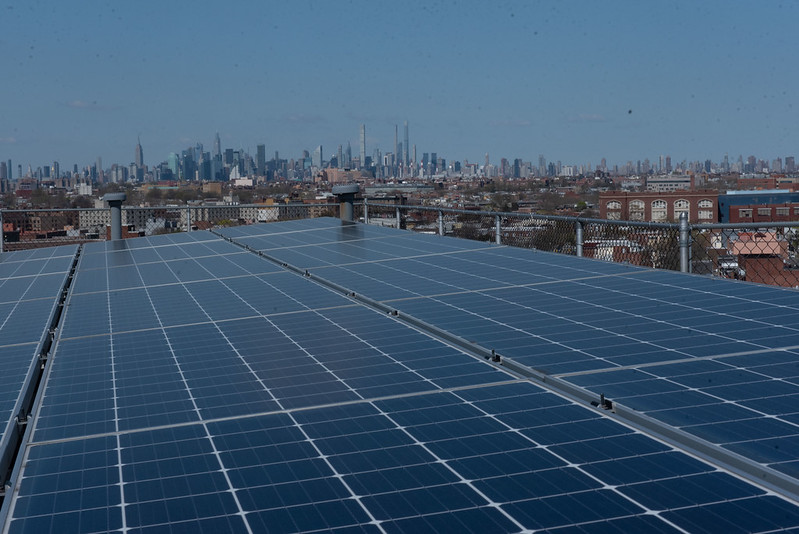
A solar future (photo: Michael Appleton/Mayoral Photography Office)
Climate change is here – and it is here to stay unless we take immediate action. One simple but meaningful way to make an impact is to empower property owners with the tools they need to reduce or altogether eliminate building emissions.
Fortunately, the New York City Department of City Planning’s proposed City of Yes: Carbon Neutrality is up to the task. This zoning reform (a “zoning text amendment” in land use jargon) will help New York meet its goal of cutting 80% of carbon emissions by 2050.
At the New York State Association for Affordable Housing (NYSAFAH), our members want to retrofit their buildings to reduce their carbon footprints, but archaic zoning rules stand in the way – rules created 60 years ago, in an era when asbestos insulation and leaded gasoline seemed like pretty good ideas. City Planning has put forth the right proposal to deal with this challenge, and now we just need the City Council to approve it.
Many affordable housing developments across the five boroughs were built in another era, long before energy efficiency became a priority – and long before modern tools were conceptualized and brought to market. What’s more, many affordable and public housing developments were built in low-lying areas that are particularly vulnerable to climate threats like storm surges and rising sea levels. In fact, we’ve already seen the damaging impacts from Superstorm Sandy, Hurricane Ida, and other extreme weather events that are only growing more common.
Among other benefits, the proposed zoning tweaks would allow elevated solar panels to cover 100% of a roof area, possibly increasing potential solar energy generation by 290%. This is a massive step to improve solar energy progress in New York – a need that will only grow as electrification continues to gain prominence.
City of Yes: Carbon Neutrality would also enable building retrofits for exterior insulating panels, which will help prevent energy waste. Adding insulation inside a building often reduces apartment sizes and leaves gaps in the façade for heat to leak. Due to floor-area regulations for affordable housing properties, developers are often prevented from installing exterior cladding. The zoning change would help remove those arbitrary and outdated restrictions.
Heating and cooling systems across buildings are vital for reducing the city’s overall carbon footprint. Most New York building furnaces and boilers run on natural gas and oil, accounting for about 42% of the city’s total greenhouse emissions. However, current zoning text restricts infrastructure on roofs and yards, often preventing building owners from pursuing electrification. City of Yes: Carbon Neutrality would expand the ability to place HVAC equipment, like heat pumps, in these areas for more efficient energy systems.
In other words, these are minor changes everyone already agrees with that will have a big impact – and they are examples of the sort of proactive climate thinking New York needs.
Every day that the zoning text goes unchanged is another one that we are preventing more responsible, ethical energy practices in New York City. We cannot afford to skirt these changes any longer. We hope that the Community Boards, Borough Boards, Borough Presidents, City Planning Commission, and City Council will vote to approve this zoning text amendment as soon as possible. New Yorkers deserve no less.
***
Jolie Milstein is president and CEO of the New York State Association for Affordable Housing. On Twitter @NYSAFAH.
***
Have an op-ed idea or submission for Gotham Gazette? Email This email address is being protected from spambots. You need JavaScript enabled to view it.






